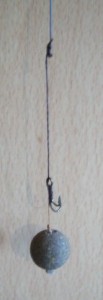A European gentleman turned up at Vaux one day last year when I was fishing. His first question was could he fish the lake, to which my reply was no. His second question was how big are the fish, because he was an angler who had travelled around to many European lakes where he had caught some large fish. We chatted generally on fishing topics whilst I continued to tie a stiff boom rig. This caught his eye and so I went on to show him half a dozen rigs along with baiting and tactics which, as a UK angler, I use.
He then wanted to share his most popular rig with me. His hook length set-up does not incorporate a hair. Instead his preference is to use soft hook baits, such as potatoes, beans and soft paste boilies which he makes himself. He presents his baits by drilling a hole through the given bait and pulling the hook into the bait so it is embedded in it. This is fished on a free running set-up so that, as he explained to me, the fish is allowed to take the bait and run, allowing sufficient time on the take for it to crush the soft boilie from the hook and so self-hook itself. If he is using potatoes or beans he would strike into the carp. He only uses small leads so the weight of it is light enough just to set the hook. He would then wind down and strike into the fish.

After I had shown him my normal set-up incorporating the stiff boom plus soft braid hook length and size 6 or 7 hook, he asked if he could tie and show me his version of a stiff boom rig with the hook he normally uses for carp fishing. Taking materials which I had in front of me, he went off and returned with the boom rig just as I would tie it, but with a double hook set-up. I was shocked, to say the least. He confirmed that this was normal practice for him and I asked whether the hooks were sold as predator or carp hooks. He replied that they are not specified and are sold for either… you make your own choice. He explained that he rarely loses a fish and never has a hook hold move in the mouth of any fish, large or small and so there is no mouth damage. Comparing the hooks we use, both barbed and barbless, with his double hook, his parting comment was that he believed our hooks would lead to mouth damage and that their double hooks are more humane.
Makes you think doesn’t it?
Chas, Etang de Vaux


Makes me think he definitely needs educating and pointing out how effective a double hook can be for stitching a carp’s throat up should he suffer deep hooking.
Nothing short of barbaric in my mind but perfect for catching hold of the odd carp back on the retrieve. Now that saves waiting for a take!
Hi Chas,
I could understand the use of a rig like this in the sixties or even the seventies. There is so much information available now for carp angler with the emphasis on fish safety, that there are no excuses for even considering using a double hook. I bet a large proportion of his fish are foul hooked.
Cheers Ron
Hi Ron
This particular angler was adamant that he never had a foul hooked fish and no second hook-ups. And it does seem to me that the largest number of foul hooked carp in a season at Vaux come to barbless hooks.
Concerning double hooks, I have witnessed an angler who was supposedly snapped off. About two hours later, that same angler hooked into a carp which he landed and which was then found to be that same carp. When it was on the mat I observed that it had been hooked with a double hook set-up, each hook with its own hook length. This 37lb carp was still dragging a lead and a leader in its mouth, but its feeding pattern had obviously not been affected
I am aware of four double hook rigs, one being a helicopter set-up. The helicopter section has a pop-up and the second hook length incorporates a bottom bait.
Another is a bolt rig set-up fished with an inline lead which has a bottom bait hook length, fished conventionally to the inline lead. The rig set-up also incorporates a helicopter section which is fished safely, that is to say if there is as crack-off on the cast or on a snagged fish, either by the bottom bait or the pop-up hook length, the carp can easily drop the lead. The way this rig works (whereby the lead is lost on a take either by the bottom bait hook length or the helicopter) is one of the technically safest I have seen for losing the lead, but it does not mean to say that we condone the use of double hook set-ups
Regards, Chas
I think that the hook he is using is a fly fishing hook and they use them when they are not allowed to use lead head flies and want to get the fly down deep. I used to fish with a guy from the Ukraine and he told me that they have no issues fishing with 2 hooks there ( Sea style) . Though they are not fishing catch and release…
I am reminded of ECHO’s motto – education not condemnation